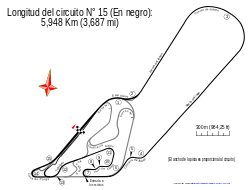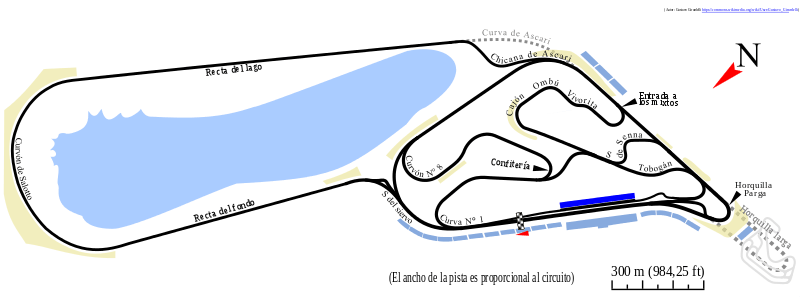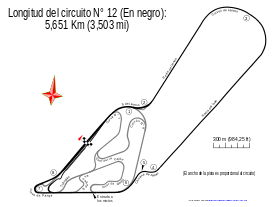Autódromo Juan y Oscar Gálvez
 Shows the main track with as used for F1 between 1995 and 1998  Shows the entire track including the lake extension, as used for F1 from 1974 to 1981 | |
| Location | Buenos Aires, Argentina |
|---|---|
| Time zone | GMT −3 |
| Coordinates | Coordinates: 34°41′39.38″S 58°27′33.65″W / 34.6942722°S 58.4593472°W |
| Major events | Argentine Grand Prix, Turismo Carretera, TC2000, World Sportscar Championship |
| No. 6 circuit (1952–present) | |
| Surface | Asphalt |
| Length | 4.206 km (2.614 mi) |
| Turns | 19 |
| Lap record |
1:27.981 ( |
| No. 15 circuit (1968–present) | |
| Length | 5.968 km (3.708 mi) |
| Turns | 16 |
| Lap record |
1:42.665 ( |
| No. 9 circuit (1952–present) | |
| Length | 3.346 km (2.079 mi) |
| Turns | 14 |
| Lap record |
1:10.540 ( |
| No. 2 circuit (1952–1967) | |
| Length | 3.912 km (2.431 mi) |
| Turns | 13 |
| Lap record |
1:36.1 ( |
The Autódromo de Buenos Aires Oscar y Juan Gálvez (official name) [1] is a 45,000[2] capacity motor racing circuit in Buenos Aires, Argentina built in 1952 under president Juan Perón, named Autódromo 17 de Octubre until Perón's overthrow (17 October (Loyalty Day) was a date of great significance to Perón's political party).
- 1952–1958: Buenos Aires Grand Prix (La Temporada) – Formula Libre [3] (circuits: No.4, 1952 – No.2, 1953–1958)
- 1953–1998: Argentine Grand Prix – Formula 1 [4] [5] (circuits: No.2, 1953–60 – No.9, 1971–73 – No.15, 1974–81 – No.6, 1995–98)
- 1964–1978: Buenos Aires Grand Prix – Formula 2, Formula 3, Formula Junior (circuits: No.4 1964, No.15 1966–68, No.12 1978)
- 1983–1985: Buenos Aires Grand Prix – Formula 2 Codasur (circuit No.4)
- 1954–1960 / 1970–1972: 1000 km of Buenos Aires sports car series Grand Prix [6] [7] [8] (1952 circuit No.1 plus various street layouts)
- 1961–1999: Argentine motorcycle Grand Prix [9] (circuit No.6)
Description
The circuit is located in a park in the southern part of the city, and is situated on flat lands surrounded by large grandstands, giving most spectators an excellent view area of the whole circuit. Some races were run without the twisty infield section, reducing lap times significantly.
The 1000 km Buenos Aires sports car event used the Autódromo as well as sections of highway situated near the track from 1954 to 1960. The 1000 km event would return again from 1970 to 1972, but using just the Autódromo section.
The 20 Formula One Argentine Grand Prix races were held in the Autódromo between 1953 and 1998. Formula One used a number of different configurations—the No.2 circuit was used from 1954–1960, the No.9 circuit was used from 1971–1973, and the very fast No.15 layout was used from 1974–1981 which added 2 long straights and a long third corner between the two straights often taken in top gear totally flat out, which provided an exciting view for spectators, especially when the cars exited the third corner often on the brink of spinning off or crashing at 180–190 mph. Going through that section, the cars were flat out for 40 seconds. The Argentine Grand Prix was dropped from the 1982 calendar because of Argentina's recovery of the Islas Malvinas and Carlos Reutemann's sudden retirement after the 1982 Brazilian Grand Prix. The twisty No.6 configuration was used from 1995–1998, but that version of the circuit was not popular with Formula One, and after the 1998 race there was no money for the race to be held and it was dropped.
Ten Argentine motorcycle Grand Prix race were held in the Autódromo between 1961 and 1999.
The Buenos Aires Grand Prix was held in the Autódromo from 1952 to 2009.

Names
- 1952–1955: Autódromo 17 de Octubre
- 1955–mid 1960's: Autódromo Municipal Ciudad de Buenos Aires
- mid-1960's-1989: Autódromo Municipal del Parque Almirante Brown de la Ciudad de Buenos Aires
- 1989–2008: Autódromo Oscar Alfredo Gálvez
- 2008–present: Autódromo Juan y Oscar Gálvez
Circuits
-
.svg.png)
Circuit N° 2
-
.svg.png)
Circuit N° 4
-

Circuit N° 5
-

Circuit N° 6
-

Circuit N° 7
-

Circuit N° 8
-

Circuit N° 9
-

Circuit N° 12
-

Circuit N° 15
Fatal accidents
List of Autodromo de Buenos Aires fatalities
Major events
- Formula One Argentine Grand Prix
- Argentine motorcycle Grand Prix
- 1000 km Buenos Aires
- Buenos Aires Grand Prix
- 200 km de Buenos Aires
- 200 Miles of Buenos Aires
Principal categories
- Formula Libre Buenos Aires Grand Prix
- Formula One
- World Sportscar Championship
- Formula Three Sudamericana
- Turismo Carretera
- Stock Car Brasil
- Grand Prix motorcycle racing
- TC2000
- TRV6
- Formula Truck
The track hosted many non-championship races, including Formula 3000, European Formula Three and European Formula Two.
Concerts
The 2007, 2008, 2010 and 2011 Creamfields editions were held in the track, The Chemical Brothers, Carl Cox, John Digweed, LCD Soundsystem, James Zabiela, 2 Many DJs, Tiefschwarz, Steve Lawler, Satoshi Tomiie, Booka Shade, Deadmau5, David Guetta, Calvin Harris, among others playing here.
External links
- Official site (Spanish)
- Aerial photo (Google Maps)
References
- ↑ "Buenos Aires (Tracks)". silhouet.com. Retrieved March 20, 2014.
- ↑ "Autódromo Juan y Oscar Gálvez". worldofstadiums.com. Retrieved 17 June 2016.
- ↑ "South American Formula Libre/Temporada Races". teamdan.com. Retrieved June 14, 2015.
- ↑ "1953 Argentina – I Gran Premio de la Republica Argentina". jmfangio.org. Retrieved March 20, 2014.
- ↑ "VII Gran Premio de la Republica Argentina 1953". formula2.net. Retrieved April 12, 2014.
- ↑ "Buenos Aires – List of Races (Sports Car)". racingsportscars.com. Retrieved June 14, 2015.
- ↑ "Latin American Sports Car Races (1954 National Buenos Aires)". wsrp.cz. Retrieved June 14, 2015.
- ↑ "South American sportscar races". forums.autosport.com. Retrieved June 14, 2015.
- ↑ "250cc Race Classification 1961". motogp.com. Retrieved April 12, 2014.